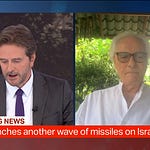There is a broader goal to this operation, which is one of regime change. It's fundamentally the same strategy that underlies Israel's operations in the Gaza Strip." — James M. Dorsey talks to Modern Diplomacy’ s Rahmeen Siddique.
The Middle East is currently teetering on the brink of a regional conflagration, as the long-simmering shadow war between Iran and Israel has erupted into direct military confrontation. As award-winning journalist and scholar James M. Dorsey aptly highlighted in recent commentary, what we’ve witnessed in the past 24-48 hours is a profound and unsettling shift, demanding a nuanced understanding of its strategic underpinnings and potential trajectories.
Israel’s recent “Operation Rising Lion” marks a pivotal moment. This wasn’t merely a retaliatory strike; it was a comprehensive and audacious offensive aimed at the heart of Iran’s military and nuclear infrastructure. As Dorsey points out, Israel has long harboured the desire to directly confront Iran’s nuclear ambitions, a move previously restrained by successive U.S. administrations. The operation’s targets – Iran’s Defence Ministry, nuclear facilities at Natanz and Isfahan, and key IRGC commanders and nuclear scientists – underscore a clear objective: to severely damage, if not dismantle, Iran’s nuclear program. Beyond that, the precision and effectiveness of these strikes, as Dorsey notes, unequivocally demonstrated a stunning degree of Israeli military and intelligence superiority.
But the strategic message goes deeper than just nuclear deterrence. Prime Minister Netanyahu has, as Dorsey articulated, hinted at a broader goal: regime change. This strategy mirrors Israel’s approach in Gaza, where collective punishment of the population is, in part, designed to foster an uprising against Hamas. Netanyahu’s explicit remarks yesterday, suggesting the attacks offered Iranians an opportunity to “regain their freedom,” reveal a clear intent to leverage military pressure for internal political upheaval in Iran.
The timing of this significant Israeli strike, despite its ongoing involvement in Gaza, is crucial. Dorsey offers compelling insights into this decision-making. He suggests that Netanyahu read Washington’s stance astutely. While President Donald Trump initially cautioned against such a strike, the fact that the U.S. was informed in advance and subsequently evacuated non-essential personnel from Baghdad and other Middle Eastern capitals indicates a tacit, if reluctant, green light. Trump’s latest comments, praising the operation as “excellent” and hinting at “more to come,” suggest he now perceives it as leverage to force Iran into a more amenable negotiating position, particularly regarding the nuclear deal. Trump’s transactional approach to diplomacy, where demands are laid out with threats of severe consequences, plays directly into this. This isn’t to say Trump pre-planned it, but he is certainly “getting on the bandwagon,” as Dorsey put it.
Furthermore, the operation serves to restore Israel’s military and intelligence credibility, which some might argue was perceived as dented by the protracted conflict in Gaza. While Israel has achieved significant military objectives in Gaza, it has not fully occupied or administered the Strip, leading to a perception of an incomplete victory. The strikes on Iran, therefore, project an image of decisive power and capability. A “cherry on top” for Netanyahu, as Dorsey highlights, was the postponement of a French-Saudi conference aimed at furthering a two-state solution for the Israeli-Palestinian conflict. This temporarily shifts the focus away from Gaza and Palestinian issues, which is a strategic win for Israel’s current government.
The extent of U.S. involvement in this strike, and going forward, remains a critical question. While the U.S. was informed, its direct participation in the strike is unlikely. However, future involvement will depend heavily on Iran’s response. Should Iran target U.S. bases in the region, or French or British facilities, the calculus would change dramatically. Dorsey also points to a significant domestic dynamic within the U.S.: a split in Trump’s Republican base, with some senior members supporting Israel’s actions, while others, including influential conservative commentators, emphasize that this is “not our war.” This division could complicate Trump’s ability to fully commit U.S. resources if the conflict broadens.
Iran’s retaliatory strike on alleged Israeli intelligence sites, while not new in concept (Dorsey notes similar actions last year), adds another layer to the dangerous escalation. The Iranian claim of possessing vast Israeli nuclear documents, while unverified unlike Israel’s public release of Iranian nuclear archives, serves as a propaganda counterpoint, highlighting the information warfare aspect of this conflict.
The regional and international implications are profound. The Gulf states, unlike in 2015 when they viewed Iran as an imminent threat needing to be countered, now prioritize economic cooperation and freezing differences. They are deeply concerned about a full-blown war, as evidenced by Saudi Arabia’s strong condemnation of Israel’s operations. Any attack on American facilities in the Gulf, which would place these states on the front lines, is a grave concern. Russia and China, while observing, also have their own strategic interests at play, particularly concerning energy stability and regional influence.
Can the U.S. leverage this situation to force Iran back to the nuclear deal? Dorsey is sceptical. He emphasizes that the Iranian regime has endured 46 years of varying degrees of pressure without bowing. While the 2015 nuclear agreement might have been seen as a concession, Iran has consistently maintained it does not seek nuclear weapons. Iran’s decision to enrich uranium to 60% was, in Dorsey’s view, a direct consequence of Trump’s 2018 withdrawal from the JCPOA, a gradual violation of the agreement’s terms in response to American pressure. Iran, in this sense, is “a victim of its own strategy.”
Finally, the prospect of regime change in Iran through external intervention is highly unlikely. As Dorsey aptly asks, there are very few historical examples where external forces have successfully brought about popular regime change, rather than merely installing a new regime. Iranians, he asserts, if they desire liberation, will have to achieve it themselves; it will not come from the air force of another country.
The critical question now is de-escalation. While an Iranian refusal to attend the sixth round of U.S.-Iranian nuclear negotiations would not be surprising, Dorsey suggests it would be wise for them to go, even if it’s out of character. The framing of any refusal as a postponement rather than a cancellation, linked to the cessation of Israeli strikes, offers a sliver of hope for future dialogue. We are undoubtedly in for a prolonged cycle of retaliation, at least in the coming days. The crucial factor will be whether both sides can eventually claim a degree of “victory” sufficient to halt the escalation, preventing this perilous new chapter from spiraling into an all-out regional catastrophe.












Share this post